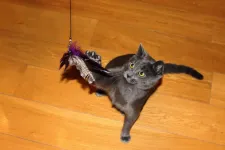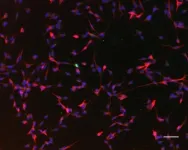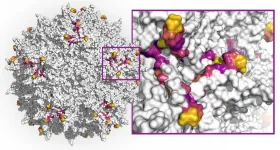INFORMATION:
Other contributors to this work include David Cardenas, Brian York, Qin Feng, Neil McKenna and Subhamoy Dasgupta. The authors are affiliated with one or more of the following institutions: Baylor College of Medicine, University of Houston and Roswell Park Comprehensive Cancer Center, Buffalo, N.Y.
This work was supported by NIH grants (HD80818/HD07857) and Cancer Prevention and Research Institute of Texas grants (RP100348, RP101251 and RP170500). Further support was provide by CPRIT Core Facility Support Award (CPRIT-RP180672), P30 Cancer Center Support Grant (NCI-CA125123), NIH RR024574 and NIH S10 OD025251 (Union BioMetrica BioSorter) and by the Brockman Foundation.
SRC-3 is a novel regulator of human immune T regulatory cells
2021-02-11
(Press-News.org) A study led by researchers at Baylor College of Medicine reveals a novel role of the steroid receptor coactivator 3 (SRC-3/NCOA3), a protein crucial for steroid hormone function and a prognostic marker for aggressive human breast and other cancers.
The team discovered that SRC-3 also regulates human immune T regulatory cells (Tregs), which contribute to the regulation of the body's immunological activity by suppressing the function of other immune cells, including those involved in fighting cancer. The study, which appears in the journal Scientific Reports, shows that Tregs whose SRC-3 function was eliminated failed to suppress the activity of other immune cells in the lab. The authors anticipate that their findings may help in the fight against cancer in the future by leading to new approaches to inhibit Tregs activity which consequently would release immune attack in tumors.
"Tregs play an important role by suppressing immune activity that can potentially harm the body," said co-corresponding author, Dr. Bert O'Malley, chancellor and professor of molecular and cellular biology at Baylor. "For instance, Tregs are critical to prevent autoimmunity, an immune response directed against normal tissues of a person, which can lead to severe disease."
In addition, breast cancer and other types of tumors include infiltrating immune cells that can contribute to the control of tumor growth or, on the other hand, provide local immune suppression that would favor tumor growth. Treg infiltration has been experimentally proven in breast tumor biopsies and correlates with poor prognosis and reduced patient survival.
"Dr. O'Malley's lab is the leader in SRC-3 research," said co-first author Dr. Bryan Nikolai, adjunct assistant professor molecular and cellular biology at Baylor and senior scientist at CooperGenomics. "SRC-3 is well-known for its role in cancer formation and proliferation, but we wondered what role it would play in immune T cells. A review of bioinformatics data revealed that SRC-3 is highly expressed in Tregs and this encouraged us to pursue this study."
"We experimentally show that SRC-3 is significantly enriched in both murine and human Tregs," said co-first author Dr. Prashi Jain, instructor of molecular and cellular biology at Baylor. "Working with human Tregs, we used our small molecule inhibitor SI-2 to effectively inhibit SRC-3 in Tregs. As a result, Tregs greatly reduced their ability to inhibit the activation of other immune cells that help in maintaining antitumor immunity."
The O'Malley lab had previously shown that SI-2 eliminates SRC-3 in breast cancer cells and, consequently, inhibits tumor growth in a mouse model of breast cancer. "Now that we know that SRC-3 also plays a key role in the immune system, I am excited to see whether our SRC-3 small molecule inhibitors might provide a dual benefit, eliminating cancer cells directly and also blocking the suppressive activity of Tregs, like killing two birds with one stone," said co-author Dr. David Lonard, associate professor of molecular and cellular biology and member of the Dan L Duncan Comprehensive Cancer Center at Baylor.
"There is a great deal of interest in finding ways to inhibit Tregs that suppress the immune system," said O'Malley, a member of Baylor's Dan L Duncan Comprehensive Cancer Center. "We are excited about the possibility that our approach with small molecule inhibitors might lead to promising therapies in the future. If we can remove the suppressive effect Tregs have in anticancer immune response with our small molecule inhibitors, the immune system then would be free to go after the tumor."
ELSE PRESS RELEASES FROM THIS DATE:
Small mammals climb higher to flee warming temperatures in the Rockies
2021-02-11
The golden-mantled ground squirrel (Callospermophilus lateralis) is a popular sight among tourists in the Rocky Mountains--the small rodent is a photogenic creature with a striped back and pudgy cheeks that store seeds and other food.
But there's a reality that Instagram photos don't capture, said Christy McCain, an ecologist at the University of Colorado Boulder. In a new study spanning nearly 13 years, she and her colleagues discovered that the ground squirrel has joined many other small mammals in Colorado's Rocky Mountains that are making an ominous trek: They're climbing uphill to avoid warming temperatures in the state brought on by climate change.
"It's frightening," ...
Hubble uncovers concentration of small black holes
2021-02-11
Globular clusters are extremely dense stellar systems, in which stars are packed closely together. They are also typically very old -- the globular cluster that is the focus of this study, NGC 6397, is almost as old as the Universe itself. It resides 7800 light-years away, making it one of the closest globular clusters to Earth. Because of its very dense nucleus, it is known as a core-collapsed cluster.
When Eduardo Vitral and Gary A. Mamon of the Institut d'Astrophysique de Paris set out to study the core of NGC 6397, they expected to find evidence for an "intermediate-mass" black hole (IMBH). These are smaller than the supermassive black holes that lie at the cores of large galaxies, but larger than stellar-mass black holes ...
Echocardiographic screening for rheumatic heart disease in Nepal
2021-02-11
Rheumatic heart disease (RHD) develops as a long term complication of childhood streptococcal angina. Latent RHD can be detected with echocardiography years before it becomes symptomatic. RHD is curable when treated early with medication.
RHD is responsible for over 300 000 deaths worldwide each year, accounting for just over two-thirds of all deaths from valvular heart diseases. RHD is disproportionally prevalent across sub-Saharan Africa, South Asia and the Pacific Islands and largely a phenomenon of marginalized communities in developing and emerging countries whereas ...
Recommendations for regional action to combat marine plastic pollution
2021-02-11
Millions of tonnes of plastic waste find their way into the ocean every year. A team of researchers from the Institute for Advanced Sustainability Studies (IASS) in Potsdam has investigated the role of regional ocean governance in the fight against marine plastic pollution, highlighting why regional marine governance should be further strengthened as negotiations for a new global agreement continue.
In recent years, images of whales and sea turtles starving to death after ingesting plastic waste or becoming entangled in so-called ghost nets have led to a growing ...
To help keep cats from killing wildlife, add more meat and play to their day
2021-02-11
Domestic cats are a major threat to wild species, including birds and small mammals. But researchers reporting in the journal Current Biology on February 11 now have evidence that some simple strategies can help to reduce cats' environmental impact without restricting their freedom. Their studies show that domestic cats hunt less when owners feed them a diet including plenty of meat proteins. Equally, it helps to play with them each day in ways that allow cats to mimic hunting.
"While keeping cats indoors is the only sure-fire way to prevent hunting, some owners ...
Play and meaty food reduce hunting by cats
2021-02-11
Domestic cats hunt wildlife less if owners play with them daily and feed them a meat-rich food, new research shows.
Hunting by cats is a conservation and welfare concern, but methods to reduce this are controversial and often rely on restricting cat behaviour in ways many owners find unacceptable.
The new study - by the University of Exeter - found that introducing a premium commercial food where proteins came from meat reduced the number of prey animals cats brought home by 36%, and also that five to ten minutes of daily play with an owner resulted ...
Artificial intelligence generates new diversity of AAV capsids for broader gene therapy
2021-02-11
Cambridge, MA - February 11, 2020 - Dyno Therapeutics, a biotech company applying artificial intelligence (AI) to gene therapy, today announced a publication in Nature Biotechnology that demonstrates the use of artificial intelligence to generate an unprecedented diversity of adeno-associated virus (AAV) capsids towards identifying functional variants capable of evading the immune system, a factor that is critical to enabling all patients to benefit from gene therapies. The research was conducted in collaboration with Google Research, Harvard's Wyss Institute for Biologically Inspired Engineering and the Harvard Medical School laboratory of George M. Church, Ph.D., a Dyno scientific co-founder. The publication is entitled "Deep diversification ...
Compounds from apples may boost brain function
2021-02-11
Natural compounds found in apples and other fruits may help stimulate the production of new brain cells, which may have implications for learning and memory, according to a END ...
Machine-learning how to create better AAV gene delivery vehicles
2021-02-11
(Boston) -- Adeno-associated viruses (AAVs) have become promising vehicles for delivering gene therapies to defective tissues in the human body because they are non-pathogenic and can transfer therapeutic DNA into target cells. However, while the first gene therapy products approved by the Federal Drug Administration (FDA) use AAV vectors and others are likely to follow, AAV vectors still have not reached their full potential to meet gene therapeutic challenges.
First, currently used AAV capsids - the spherical protein structures enveloping the virus' single-stranded DNA genome which can be modified to encode therapeutic genes - are limited in their ability to specifically hone in on the tissue affected by a disease and their wider distribution throughout ...
Aggressive brain tumor mapped in genetic, molecular detail
2021-02-11
Glioblastoma is among the most aggressive and devastating of cancers. While rare compared with other cancers, it's the most common type of brain cancer. Even with intensive therapy, relatively few patients survive longer than two years after diagnosis, and fewer than 10% of patients survive beyond five years. Despite extensive studies focused on genomic features of glioblastoma, relatively little progress has been made in improving treatment for patients with this deadly disease.
Now, a new study led by Washington University School of Medicine in St. Louis, Pacific Northwest National Laboratory, Case Western Reserve University and the National Cancer Institute (NCI) of the National Institutes of Health (NIH) has revealed a detailed map of the genes, ...







